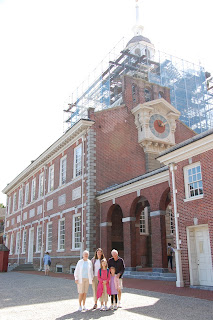We really enjoyed the canal visitor center and, in spite of our learning experiences on canals earlier in the trip, picked up new facts and interesting stories. We read about the families that lived in the canal boats, carrying cargo up and down the waterway. Their mules had a stable on board, and the young children were tethered to the deck to avoid falling overboard. One tidbit that Kelsey pegged correctly on her junior ranger book: a mule is the product of a donkey dad and a horse mother (we're not making any obtuse political statements here--promise!). And Kendall, wanting to impress the ranger when asked her favorite thing about the park, answered "The Rebution War happened near here. And my favorite president is Lincoln." :-)
The Clara Barton National Historical Park is nearby, featuring her home for the last 15 years of her life. Not just her residence, it served as the American Red Cross headquarters, a dormitory for R.C. workers, and a warehouse. She was given the land and the construction of a home of her choosing by the developers of the area, twin brothers who hoped to attract other buyers with Barton's presence in the neighborhood. Seventy-five years old when she moved in, Clara had designed her home based on a structure utilized by the R.C. during its mission in Johnstown following the flood of 1889...a modified warehouse, with rooms opening off a large, three-story atrium into which windows near the ceiling give light. The home's long hallway on the ground floor was used for assembly lines in putting together disaster-aid kits (the walls were lined with deep supply closets concealed behind the wood paneling) and as a dining room and meeting hall for large gatherings. And rather than waste donation money on such "frivolous" things as paint and wall board, Clara had muslin fabric, the same as that used for bandages, tacked onto the ceilings and walls.
She may have seemed a bit out of place with the other residents of the neighborhood, which was named Glen Echo by the developers. The Batzley brothers established the area as a vacation resort, complete with an amusement park and enrichment activities. The park's carousel remains fully operational, and we were really fortunate to get a private, behind-the-scenes tour of it. A Wurlitzer organ accompanies the spinning animals, and it's one of only three operational, publicly displayed organs of its type in the world. The carousel and organ are more than 90 years old, and they're by far the most beautiful we've ever seen. The girls picked their favorites of the animals, all of which have patches in the restored paint that show the original color and texture. They're lovingly cared for by one woman; she spent 20 years on the initial restoration, completing it in 2003.
The carousel holds another distinction--it was the site of one of the earliest civil rights demonstrations. In 1960, students from nearby Howard University staged a sit-in on the carousel and, soon after, the federally-held trolley tracks leading into the park, protesting the owners' segregation policies. The following summer season, the park finally opened to all. It was one more chapter in Maryland's long history of racial conflict...it was a divided state during the Civil War, a member of the Union despite its slave-dependent economy. Brothers literally fought brothers here. Now that our travels have brought us into the regions directly affected by the Civil War, it was sobering to be in a place today that has a more recent history in the struggle for liberty.
 |
| Mules pulling a boat along the C&O Canal |
 |
| Great Falls, separating Virginia and Maryland |
 |
| Two of the rangers, wearing interpretive garb, at the canal park. Kelsey and Kendall had just taken their junior ranger oath. |




















































